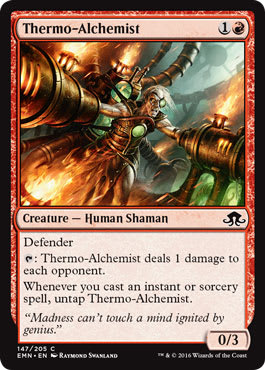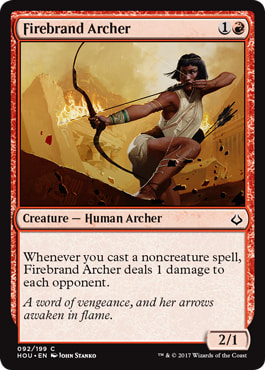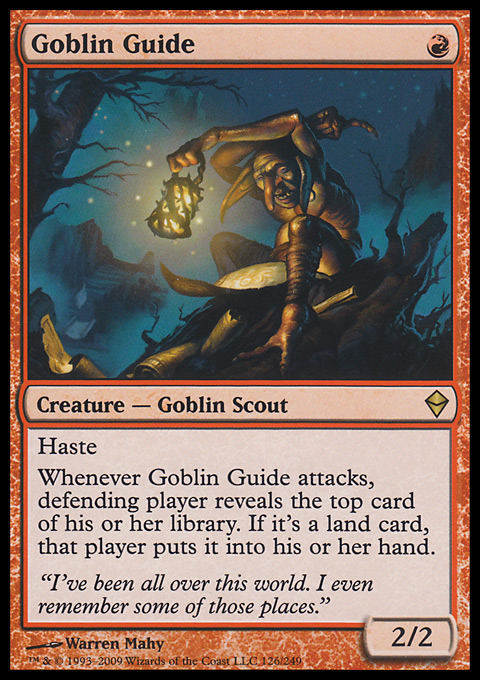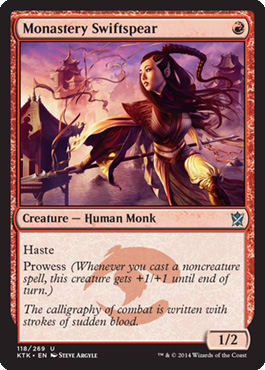One of the many appealing things about the Pauper format is its ease of access to players, new and old alike. For many, Standard is a great starting point but can become difficult as they realize how expensive it can be to keep up. When they see something like Modern, nevermind Legacy or Vintage, they're often overwhelmed by both the upfront costs as well as the difficulty and complexity of the gameplay. The commons-only format offers a great deal of variety and ways to play, but giving a new player something like Tron might be a bit much. The key then becomes finding a happy medium; something they can play competitively at a beginner level and grow their skill. Pauper Burn gives all of these things and more.
Burn | Pauper | OSKIYAA, Pauper Challenge 9/30/18
- Creatures (8)
- 4 Firebrand Archer
- 4 Thermo-Alchemist
- Instants (19)
- 1 Shard Volley
- 2 Magma Jet
- 4 Fireblast
- 4 Lightning Bolt
- 4 Needle Drop
- 4 Searing Blaze
- Sorceries (12)
- 4 Chain Lightning
- 4 Lava Spike
- 4 Rift Bolt
- Enchantments (3)
- 3 Curse of the Pierced Heart
- Lands (18)
- 16 Mountain
- 2 Forgotten Cave
- Sideboard (15)
- 1 Flaring Pain
- 2 Electrickery
- 2 Staggershock
- 3 Martyr of Ashes
- 3 Molten Rain
- 4 Smash to Smithereens
Playing Burn is the same in Pauper as it is in most other formats. All you need to be able to do is count to twenty and remember the age old phrase "face is the place." Playing spells like Lightning Bolt, Chain Lightning, and Lava Spike let you get damage in quick. At the same time, your creatures like Thermo-Alchemist and Firebrand Archer generate tremendous amounts of small damage, block creatures, and even attack. Curse of the Pierced Heart creates inevitability against decks that take a long time to get going. Lastly, when you're ready to go in for the kill, you sacrifice two Mountains for a free Fireblast to obliterate your opponent.
All of this seems easy but relies on a bit of strategy. In this sense, Burn is like many decks in that it's easy to pick up and play but is a little trickier to master. For example, there's a bit of strategy in deciding when you should handle an opponent's threat on the board instead of sending your spells upstairs. This includes knowing to bolt the right elf in that deck's namesake or when to anticipate a counterspell or Vines of Vastwood. This requires format knowledge that comes with time. As you play more you gain knowledge of how many decks play and can begin to anticipate how to deal with them.
Another thing for new players to watch out for is missing triggers from creatures like Firebrand Archer or Thermo-Alchemist. While the Archer's ability is easier to keep track of since it deals damage with its only trigger, Thermo-Alchemist plays a little different. Missing Archer triggers at a Competitive REL event might just mean you missed out on some damage but it's easier to fix at a Regular REL event, simply marking the damage dealt. Because Thermo-Alchemist untaps and you need to activate it yourself, it's harder to rewind or mark a proper change in life totals. As such, minding your triggers can both help maximize damage and be the difference between a win and a loss.
Both of these creatures are actually fairly recent to the archetype. Older builds ran creatures like Keldon Marauders and Spark Elemental. While these cards make rare appearances still, the Archer and Alchemist both often outclass them. More rarely you saw pure creature-less lists utilizing cards like Incinerate for extra, if more expensive, three-damage burn spells. We still see contention in some slots even. The list above contains Magma Jets and a Shard Volley but oftentimes these are represented by the aforementioned Incinerate, Lightning Strike, or Flame Rift. With all these card choices, it's hard to say the absolute best version of Burn to play, but a recent card from Dominaria added a fresh take on the deck in the last few months.
Ghitu Lavarunner now sees play in decks, usually replacing one of the now staple pinging creatures in favor of some quick aggressive damage. By turn two, it's not uncommon to have multiple spells in your graveyard, after all. It's also not easily blockable early on by a lot of decks, meaning it will often be something to the effect of a two-to-six damage burn spell for one Red mana. If you know anything about other formats, this kind of creature may feel a bit familiar.
(card pics: Goblin Guide, Monastery Swiftspear)
The comparisons to these cards don't go unnoticed. The Lavarunner has even been affectionately referred to as "Garbo Guide" in honor of the iconic Goblin. This leads me into another cool discussion point about the Pauper version of Burn: it's easily upgradable to the Legacy version. You might be wondering why Legacy and not Modern. Simply put, some older cards played in Pauper Burn, like Chain Lightning, Fireblast, and Flame Rift, are playable in Legacy but not Modern. In addition, Modern requires a greater investment on things like a mana base.
However, Legacy Burn largely requires you to pick up Goblin Guides and Eidolon of the Great Revels, often key cards in Modern Burn as well. Some versions also run fetch lands with Grim Lavamancer. By converting your lists, you can start building into Legacy and from there work into Modern. Because you're playing against higher power decks as well, you gain more opportunities to learn about the intricacies of the game, bettering yourself as a player. As such, Pauper Burn continues to be one of the best ways to enter the game.
Lastly, Pauper Burn features a great suite of sideboard cards. Sweepers like Martyr of Ashes and Electrickery take care of problematic go-wide decks with great effectiveness, as does the lesser-used Blazing Volley. Molten Rain usually is reserved for Tron lands but can work to your advantage against certain other decks that lean in too heavily on non-basics, like Boros Monarch for example. Smash to Smithereens is great for dealing with Affinity while burning your opponent to death but sometimes Gorilla Shaman sees a little play as well. Finally, Flaring Pain stops your opponent from preventing your damage with something like Prismatic Strands or Circle of Protection: Red.
With lots of great ways to play this deck in the traditional sense, it's a wonderful pickup for many. The recent reprinting of Chain Lightning in Battlebond just made the deck all the more accessible for many. Many newer players often play it and due to its cost, it shows up frequently on Magic Online. Because of the current meta, the over prevalence of the deck, and the affordable nature of it, the deck is appearing more than ever. Much to the chagrin of many, it's here to stay, a force to be reckoned with and forever a pillar of the format. And until something comes to upset it, that pillar is going to continue setting many a tournament match ablaze.





























